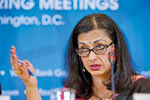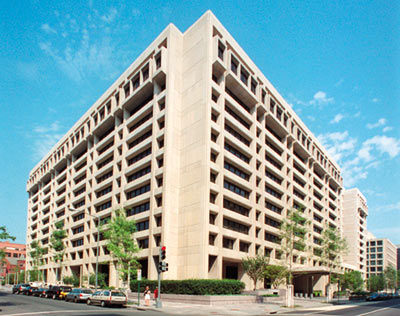IMF bailout facility instills confidence of donor agencies on Sri Lanka, says IMF Deputy Director

Kalpana Kochhar
I am sitting at a posh office room on the 7th floor of the IMF headquarters in Washington D.C., waiting for Kalpana Kochhar, deputy director of the IMF’s Asia-Pacific department. When she arrives, walking along the corridor neatly dressed in black, I am surprised over her resemblance to my one time favourite Hindi film star of yesteryear Saira Banu. During an exclusive interview with Kalpana, I was surprised again at her in-depth knowledge and assessment of Sri Lanka’s economic ups and downs in the past two decades. As Sri Lanka struggles to keep its economy afloat in the midst of a Balance of Payment (BOP) and debt crisis, what role does the International Monetary Fund play?
Ms Kochhar brings over two decades of experience to her coverage of countries from India, Sri Lanka and all the way to Australia and New Zealand. Her research focuses on the region’s economic growth, fiscal policies and financial sector. In this interview with Business Times on the sidelines of the IMF Spring meetings last week, she explains why Sri Lanka’s tax reforms need to move faster with the commitment of tax and the Treasury department staff and why its support facility is so important for continued progress in the island nation. She noted that the IMF support programme will instill confidence of other lending agencies and donor countries to make their financial contributions and investments to rescue the country from the present economic abyss.
The IMF facility would also trigger “a lot of” new lending from multilateral and bilateral agencies such as the World Bank, the Asian Development Bank and the Japanese International Cooperation Agency (JICA), she said adding that the country could expect a total financial package of US$2 billion although the Extended Fund Facility (EFF) which would be around $.2 to $1.5 billion. Ms Kalpana emphasised the need for raising tax revenue by implementing the proposals relating to the 15 per cent VAT revision, NBT and other taxes and stop excess government borrowing in a bid to get out of the debt trap. She noted that Sri Lankan Treasury officials informed her that they have already prepared circulars of guidelines, revenue bills to implement tax amendments, etc and everything is now in place for the implementation of tax proposals with effect from next month.
Narrow fiscal deficit
The IMF has advised the government to urgently make a stronger effort to narrow the fiscal deficit and put the public finances on a sustainable path. While several measures in the budget (such as elimination of several special purpose levies, and the commitment to eliminate tax exemptions and bolster the efficiency of tax administration) are welcome, the IMF highlighted the macroeconomic and financial risks of a large deficit and the associated need to borrow from domestic and international markets. Despite the narrowing of the current account, capital outflows have intensified and the overall balance of payments deteriorated.
These outflows were accompanied by downward pressure on the rupee and a decline in the Central Bank’s gross foreign exchange reserves mainly due to short-term capital outflows as experienced in many emerging markets, she pointed out. She welcomed the recent tightening of monetary policy given the steady increase in core inflation and high private credit growth. However, the Central Bank should be prepared to tighten policies further if these trends continue. Below are some key excerpts from the interview (B – abbreviation for Bandula; KK – abbreviation for Ms. Kochar):
New facility
B: The IMF is now in the process of approving and Extended Fund Facility (EEF) for Sri lanka following the 20-month standby arrangement of around $2.6 billion several years ago. I was wondering how the IMF has structured this loan as according to my knowledge Sri Lanka is yet to repay some amount of the previous one and it has to fulfill previous IMF conditions as well. I would like to know about this new facility which is in the pipeline and the position of the previous standby arrangement (SBA).
KK: The 2009 Stand-By Arrangement was completed in July 2012. After the end of the programme, Sri Lanka was subject to intensive surveillance under the Post-Programme Monitoring framework given the exceptional level of access (400 per cent of quota) granted under the SBA. Four post-programme monitoring missions were completed, with the last going before the Board in November 2015. Sri Lanka’s current outstanding use of fund resources is SDR 306 million (about $558 million, or 68 per cent of quota). The Extended Fund Facility is not new – it is one of the “workhorses” of IMF facilities and has been in use for many decades.
India actually undertook a programme supported by the EFF in 1981-82 for SDR 3.9 billion (one of the largest IMF programmes of the time). When a country faces serious medium-term balance of payments problems because of structural weaknesses that require time to address, the IMF can assist with the adjustment process under an EFF. Compared to assistance provided under the Stand-by Arrangement, assistance under an extended arrangement features longer programme engagement—to help countries implement medium-term structural reforms—and a longer repayment period.
Debt trap
B: We in the mainstream media have regularly highlighted about the BOP crisis and foreign debt trap in Sri Lanka. But when going through the recent IMF mission statement the problem is not so grave. In fact, it indicates an economic growth rebound and progress in talks relating to this new facility. Could you explain as to how the IMF has arrived at this decision? What assurance has been given by the Sri Lanka government to meet IMF conditions?
KK: The March 29-April 11 mission to Colombo made significant progress toward an arrangement that could be supported under the EFF. The degree of progress reflects to some degree the close dialogue that has been maintained under the post-programme monitoring framework and an extensive set of technical assistance missions on such issues as tax policy, revenue administration, and public financial management.
B: According to IMF surveillance what is the current economic situation in the island?
KK: The IMF’s assessment of the current economic situation will be elaborated in the forthcoming Article IV Consultation, slated for the first week of June. Macroeconomic performance in 2015 reflected a mix of positive underlying growth momentum, the impact of domestic policies, and an increasingly difficult external environment. The fiscal deficit expanded, public debt increased, and the balance of payments position deteriorated despite an improvement in the terms of trade. Real GDP growth in 2016 is expected to remain around 5 per cent and inflation in the low single digits. Over the medium term, there is potential for growth to rise closer to Sri Lanka’s estimated potential output level, but prospects will hinge on a policy upgrade in the near term and removing bottlenecks to trade and investment.
Revenue collection
B: Are you optimistic about the country’s revenue collection at present? If it is not so what’s the IMF prescription to remedy the situation? KK: Revenue collection is extremely important for the fiscal consolidation and debt reduction that needs to happen to bring Sri Lanka to a sustainable fiscal position. Building revenues is not a simple task, but can be done with a combination of better tax policies (particularly broadening the tax base through elimination of exemptions, holidays, and special rates) together with stronger revenue administration.
B: Have you suggested any foreign reserve targets for Sri Lanka, after providing this IMF EEF?
KK: A path for international reserves of the Central Bank would be a key pillar of the overall macroeconomic framework that encompasses a programme supported by the EFF. In the Fund’s view, it is vital that the Central Bank takes advantage of opportunities to build non-borrowed reserves of the bank.
B: Sri Lanka’s state owned enterprises including SriLankan Airlines Mihin Air, Electricity Board and Petroleum Corporation have become money eaters (with no return). What is the view of IMF on these institutions?
KK: State-owned enterprises need to be run on a commercial footing – to avoid losses and the need for financing these losses from state banks. To accomplish this, these corporations need to be run with the ability to set prices to cost recovery (plus a margin to service investment needs and debts). It is our understanding that the government is already considering automatic pricing mechanisms that could be used to this effect.
 Progress on EFF
Progress on EFF
B: Is it possible for the IMF to enter into an agreement on EFF within weeks as highlighted in the local media?
KK: This depends on progress in resolving the remaining outstanding issues related to the conditions of the programme. We are hopeful that negotiations can be concluded soon.
B: Is it possible for Sri Lanka to get cheaper loans after a deal with the IMF is finalized?
KK: It is not uncommon for borrowing costs to decline following government announcement of an economic reform plan – supported by the macroeconomic conditions and structural benchmarks included in the conditionality framework. The announcement of a clear policy direction toward macroeconomic and financial discipline is generally welcomed by the markets.


